
Patrick was born in 1837 in England as both his parents left Ireland to live and work in textile mills there. At age 23 working as a mill operative, Patrick married Irish-born 22-year-old Catherine Welch. Their first three children: James, Ellen and Mary were all born in England. The extended Haley family immigrated to the states in November 1862 arriving in New York City. They moved to Lawrence, Mass. where they worked in the mills for two months. Beginning a new life in the new year, on January 1st, 1863 the family moved north out of the city to work in the mills in Newmarket. Patrick was 26 years old, he and his wife liked Newmarket and decided to stay here.
Their other children were born in town: John, Rosina, Cornelius, Catherine and William. With the exception of William (the baby of the family), all the children worked in the mills – they started as young as age 10, 11, or 12.
In 1881, with income from most of his family working in the cotton mill, Patrick could branch out into a new career. He leased the Newmarket Hotel and managed the Hotel and bar. He held a grand opening in April with a complimentary dinner followed by a dance for invited guests and his extended Irish family from Massachussetts. It was “A GREAT DO”. Patrick re-leased the property for a total of six years.
grand opening in April with a complimentary dinner followed by a dance for invited guests and his extended Irish family from Massachussetts. It was “A GREAT DO”. Patrick re-leased the property for a total of six years.
In January 1872 Patrick was sworn in as a US citizen. One of his witnesses was Timothy Griffin (a future owner of the Hotel) and the other was the notorious Attorney Charles H. Smith. Patrick jumped into local politics right away, as a determined Democrat. He was extremely popular in town, as evidenced in 1883 when he was voted Best Saloon Keeper and received a silver pitcher. Perhaps his popularity rose when earlier the same year he installed an air gun shooting gallery on the front porch of the hotel which brought in a lot of business from both sexes.
1883 must have a celebratory year for the Haley family, in June the Newmarket Advertiser, usually very restrained in wedding announcements, wrote of the wedding in St Mary Church between Patrick’s daughter Mary Ann Haley to Frank Gilbert Gallagher of Boston as “brilliant with the wedding ceremony being witnessed by a large concourse of relatives and friends. In the evening a reception was held at the hotel, at which there was dancing and refreshments.”
 Business was so good, despite all the encroachments of the Temperance leagues, the time was ripe to make a leap from leasee to property owner. In April 1866, the Newmarket Advertiser moved from the old Branscomb tavern making the building became available, at the same time that his Newmarket Hotel lease was up. Attorney Smith (the same attorney who helped Patrick gain citizenship) sold him the old Branscomb Tavern next to the Masonic building. [This was the same C.H. Smith who turned the top of the Newmarket House stable into the popular roller-skating rink in 1884, and headed off to France with a beautiful 17 year old mill operative whom he introduced as his “personal secretary”.] Patrick now opened his own saloon on Main Street. The family moved to quarters upstairs, while downstairs, he leased out the other side of his saloon as a grocery store. Within three months of the move, his wife Catherine died at age 50. They had been married about thirty years and had eight children. She is buried in Calvary cemetery.
Business was so good, despite all the encroachments of the Temperance leagues, the time was ripe to make a leap from leasee to property owner. In April 1866, the Newmarket Advertiser moved from the old Branscomb tavern making the building became available, at the same time that his Newmarket Hotel lease was up. Attorney Smith (the same attorney who helped Patrick gain citizenship) sold him the old Branscomb Tavern next to the Masonic building. [This was the same C.H. Smith who turned the top of the Newmarket House stable into the popular roller-skating rink in 1884, and headed off to France with a beautiful 17 year old mill operative whom he introduced as his “personal secretary”.] Patrick now opened his own saloon on Main Street. The family moved to quarters upstairs, while downstairs, he leased out the other side of his saloon as a grocery store. Within three months of the move, his wife Catherine died at age 50. They had been married about thirty years and had eight children. She is buried in Calvary cemetery.
Wheelbarrow election of 1880
Patrick was a staunch Democrat and was busy in the local party registering voters. During the Presidential Race of 1880 - William Garfield (R) v General Hancock (D) a lot of bets were played around the election; as around any sporting event, any election in any of the bar rooms was an excuse to gamble.
In the town vote the Democrat turnout was greater than the Republican, and although Garfield won the national vote, he lost in town. Therefore, as part of a very vocal and public bet placed between Blake Roberts (R) and Patrick Haley (D) —if Garfield, was to be elected President, then Roberts was to wheel Haley in a wheelbarrow from the Durham bridge to the junction, and if Hancock won, Haley was to wheel Roberts.
Garfield won, and Blake stood by the bet. At 7:30 pm on a Saturday night on November 13,1880 proceeded by the town drum corps and escorted by the Garfield Cadets, Mr. Robert Blake took up his line of march through Main Street. Patrick occupied the wheelbarrow all gussied-up in an elaborately trimmed tall hat and a brightly decorated sash, he carried the American flag in one hand, while with the other he held on to the barrow.
Blake was sure footed and bore his burden bravely, and notwithstanding the expectations and shouts of many, he did not give Pat “the dump”. The novel procession attracted much attention as it passed by the streets and was loudly met with applause and claps of pots and pans as it continued on its way to the junction. This form of a political wheelbarrow run continued for several years afterwards, until the political rivals got a little older and a little bit more winded.
Patrick had worked into his mid- seventies when poor health forced him into retirement. When Patrick died in 1916 at almost 80 years old, he had lived longer than all of his children; He was survived by three of them.
Prior to Patrick’s death, he had lost five of his children – four were under the age of 35 and one was 47. All of these offspring worked in the NMCo cotton mills as children. They are all buried in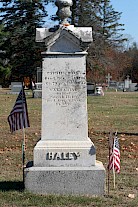 Calvary Cemetery in the family plot.
Calvary Cemetery in the family plot.
Pre-Deceased children:
1) Patrick’s eldest son James Patrick died in 1891 at age 33 of blood poisoning in New York City; and his story follows under the heading The Professor from Lowell.
2) His married daughter Mary A. Gallagher age 31 died in 1892 of hepatitis in Chelsea, MA; She was working in the mills at age 12.
3) His unmarried daughter Rosina died in 1893 at age 24 in Newmarket of dropsy, she worked in the mills at age 12.
4) His son John, a mason and brick layer died at age 33 of accidental suffocation in Boston in 1896, he was unmarried.
5) Patrick’s other son Cornelius died in 1914 at age 47. His story follows under the heading of Failed Attempt.
Surviving Children:
1) His daughter Ellen married Thomas Bresnahan in 1904 at age 43. She had been working in the mills since age 11. After Thomas died in 1919, she moved to 82 Main Street with her sister Catherine. After Catherine died of cancer, Ellen moved to Spring Street where she died at age 76 in 1935 of heart disease.
2) His unmarried daughter Catherine worked as a bookkeeper who resigned her position with the Newmarket National Bank in 1919. She died in 1928 at age 55.
3) He was also survived by his youngest child William P. Haley AKA KING HALEY whose story follows under the heading The Baseball Star.
“The Professor” From Lowell
In 1870 Patrick’s son James (1858- 1891), was working in the Newmarket cotton mills, he had been working in cotton mills her since he was 12 years old. He married Mary Gallagher in Newmarket and the couple moved to Lowell, Massachusetts to work in the cotton mills there, but James had other ambitions and he soon became known as “the Professor from Lowell”. The title of Professor was self-attributed, as he was a travelling instructor in “the manly arts” who held intensive boxing lessons in the upstairs rooms over the Rowan cigar shop next to the old Willey Hotel on Main Street. His expertise was recognized as he also taught boxing at Phillips Exeter Academy, the Page gym in Lowell, and in other cities/towns between Newmarket and Lowell.
On Christmas Eve in 1886 “the Professor” engaged in a boxing match in an eastside saloon in NYC with New York boxer James M. Long for $100 and a cut of the gate money from about 200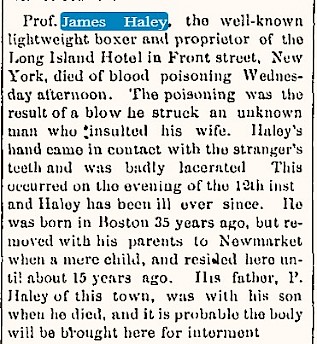 persons. The men in the audience were New York and Chicago boxing aficionados. Haley got the best of Long right from the beginning. In the second round Haley was declared the winner on a foul as Long was knocked down and his second had to pick him up. The admission for the event was $10, which in 2022 would be the equivalent of $299 for a seat. The newspaper article stated that James lived in Buffalo and Long Island, New York.
persons. The men in the audience were New York and Chicago boxing aficionados. Haley got the best of Long right from the beginning. In the second round Haley was declared the winner on a foul as Long was knocked down and his second had to pick him up. The admission for the event was $10, which in 2022 would be the equivalent of $299 for a seat. The newspaper article stated that James lived in Buffalo and Long Island, New York.
James died in New York City on September 12, 1891. He was the proprietor of the Long Island Hotel in New York when he got in a confrontation with an unknown man who “insulted his wife”. Haley’s fist connected with the stranger’s teeth and was badly lacerated, and James soon became quite ill. Patrick left Newmarket to be with his son and was with him when he died of blood poisoning. The body was brought back to town for the funeral and burial in the Calvary cemetery family plot.
Like Father Like Son – “Patsy” Haley, the Professional Pugilist
James and Mary Haley’s son Patrick James went by the name of “Patsy Haley”. Patsy was born July 20, 1877 in town and moved to Lowell with his parents. His brother George was born in Lowell in 1881 but he died of burns prior to his first birthday. Patsy came back to town and worked in the cotton mills as a youngster living with his uncle William.
Patsy then went on to create a name for himself in the boxing world. He was much more successful that his father had ever been. The following is taken from Ring Magazine in an 1951 article reporting on his death. “He left his home and began boxing at age 17 when he entered a ringside contest in Buffalo NY and won the state amateur featherweight championship. A few weeks later he turned professional, started winning bantam and featherweight bouts and cash, so he travelled around the country and was quite successful even without a manager. His name was always in the Boxing News of Brooklyn papers. In his later years he became a judge of boxing matches in New York State and worked as a Detective in the Bronx”.
The ring magazine may be a little more accurate than an article published on the Boxrec.com website Which says “Patsy’s father owned a concert hall in Buffalo, New York, known as the Bijou. When Patsy was 16, his father staged a Western New York amateur boxing tournament, which his son entered under the assumed name of “Patsy Hayes”. Haley won the first prize gold watch. His father sold the Bijou around 1895 and the family moved to New York City. His father then bought the old Long Island House from Nonpareil Jack Dempsey on Front Street.”
The facts don’t align with this online article . In 1893 when Patsy “was 16”, his father had died two years earlier September 1891. The father couldn’t have sold the Bijou in 1895, unless the estate wasn’t settled until 2 yrs after his death. Possibilities for the discrepancy would be: 1) the writer didn’t get his facts straight; or 2) We know that Patsy stayed with his Uncle William until he was 14, then he left for Lowell, and was 16 at the time his father died. Perhaps he was only 14 years old at the time of the match therefore the false name of Patsy Hayes. Ringside names were often ‘doctored” by boxers as was Patsy’s own father’s name; however, Patrick went on to fame under the name of Patsy Haley, not Patsy Hayes.

Patsy Haley (center) refereed the Welterweight Championship bout between Jack Britton and Benny Leonard on June 26, 1922. In the 13th round, Jack dropped to one knee from a body blow and protested to Patsy Haley that the punch had been low. When Haley continued to count over Britton, Benny struck Jack while he was down, and was disqualified.
(courtesy photo:http://www.harrygreb.com)
When he was 19 years old, he had already established a good reputation in the boxing circuit. Patsy would come back to town often to visit his grandfather, aunts, uncles and cousins. He created a stir when he entered into a boxing exhibition at the Newmarket town hall in 1908. The review read in part: “The boxing exhibition at the town hall last Saturday evening was an interesting event to lovers of the manly art. The preliminary bouts between some of Newmarket’s young boxers were most amusing, and the main bout between Patsy Haley of Newmarket and Kid Sullivan of Boston was a fine exhibition. Haley showing up remarkably well and Sullivan quit at the end of the sixth round, having “got enough”, as he stated it”.
On one visit to town, Patsy celebrated his grandfather’s birthday by giving him an imported Irish terrier.
 As Patsy got older, he traded in his boxing gloves for a referee shirt. He was appointed a referee by the New York State Athletic Commission. Soon became a
As Patsy got older, he traded in his boxing gloves for a referee shirt. He was appointed a referee by the New York State Athletic Commission. Soon became a New York state boxing judge and worked rings all over the state judging major matches. His most famous referee fight was the Heavyweight bout between Jack Dempsey and Jack Sharkey in NYC in Yankee Stadium in front of 80,000 fans in July 1927. “During the early days of the Walker Law, he was regarded as one of the state’s most competent arbiters. In later years he was assigned to wrestling and after a period of officiating at that sport he retired and turned in his license”.
New York state boxing judge and worked rings all over the state judging major matches. His most famous referee fight was the Heavyweight bout between Jack Dempsey and Jack Sharkey in NYC in Yankee Stadium in front of 80,000 fans in July 1927. “During the early days of the Walker Law, he was regarded as one of the state’s most competent arbiters. In later years he was assigned to wrestling and after a period of officiating at that sport he retired and turned in his license”.
(photo of Boxing Referee Patsy Haley, courtesy of Boxrec.com)
When not judging matches he worked as a private detective for the Walden Detective Agency in NYC. During WW II, he was in charge of security details at the Navy Yard in Hoboken, NJ. He never married, when he died in 1951 at age 74 his body was brought back to Newmarket for funeral services in St. Mary Church. He was buried with his father and grandparents in Calvary cemetery.
Failed Attempt – Cornelius Haley
Cornelius was put to work in the mills at age 10 and continued working most of his life as a mill operative. He worked as a stone mason for a short period of time when at age 27 he married 20-year-old Catherine Mullen in Concord, NH. Catherine was born in Ireland, the daughter of Edward and Mary Mullen, she also worked as a young girl in the mills in Newmarket alongside her father.
Prior to his marriage Cornelius had a rough and tumble life around the docks, pool halls and bars of downtown. A drunken argument in January 1898 with his father led to broken saloon windows and a few months spent in the County Jail. That’s when he left Newmarket for Concord, NH where he found grueling work as a stone mason in the Concord quarries. He married Miss Mullen in Concord in August of 1898.
In July 1908, back living in Newmarket, he and his friend Joseph Kenniston were lauded for their attempt in trying to save a drowning man in the river behind the mills. The floundering victim grabbed hold of Cornelius’s boat, tried to climb in but capsized it, throwing both Cornelius and his buddy into the Lamprey. Another two boats came out to the rescue: one boat retrieved the initial victim, and Postmaster Small rowed the overturned boat with Cornelius and Mr. Kenniston clinging alongside.
Cornelius later learned the trade of boiler maker and was employed in the Portsmouth Navy Yard in 1904. He died of pneumonia at age 63 in 1914.
The Baseball Star – William Haley
William, the baby of the family, born in 1875 appears to be the only child of Patrick and Catherine who did not work in the mills, He started school in town and finished in Exeter. He was a talented baseball player for the Newmarket Baseball teams throughout his high school years. In 1897 he entered NH College in Durham and played on the college baseball team. He was a bright, athletic, energetic youth who also played the banjo and was part of the Newmarket Social Club. In 1900 in partnership with Mat Kennedy they purchased Frederick Saunders’ market, renovated it and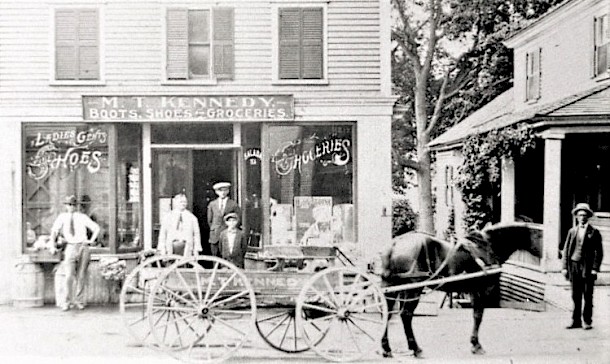 opened Kennedy’s grocery market and shoe store.
opened Kennedy’s grocery market and shoe store.
In October 1901 at age 25 he married 22-year-old Harriet Wentworth Willey a talented singer and music teacher, she was the daughter of Thomas and Elizabeth Willey in town. They had four children before Harriet divorced him in 1927 for extremely cruelty.
William or “Billy Haley” or as he was known by teammates “King Haley” made the papers in 1902 while working at his and Kennedy’s store. His notoriety was for feeding birds; he trained doves and smaller birds to fly into his hand to be fed one seed at a time.
But he was better known for his finesse on the baseball field. For several years he was the sought-after player from various seacoast teams, until 1903. During a July game he was playing second base when a player from Kittery slammed into his leg resulting in a double fracture. The bone was set by town doctors, but never healed, and he walked with a considerable limp. A year later he went to the Carney Hospital in Boston to have the leg reset.
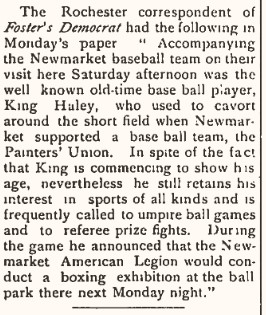 By 1910 he had gone from star player to star umpire, and umpired championship games throughout the tri-state area. He also was a referee of prize boxing fights and wrestling matches.
By 1910 he had gone from star player to star umpire, and umpired championship games throughout the tri-state area. He also was a referee of prize boxing fights and wrestling matches.
Prior to Prohibition in 1919 he worked as a liquor salesman, and behind the bar at his grandfather’s pool hall and saloon. When the liquor business dried up, he found employment with the NMCo. He was Eagles president in 1923, and he also served as an elected officer with the Forresters before his death at age 72 of heart disease in 1947.
King Haley’s son — William Howard Haley (1906-1958) followed in his father’s footsteps. He was Newmarket High School star pitcher in the spring of 1922 who entered Philips Exeter Academy in Sept 1923 and graduated from Exeter the following year. He was their most promising pitcher. While in high school at Newmarket, he was class president and also played in the semi-professional seacoast league. He was a husky lad who played football for the Newmarket team; however, in Exeter he was selected to play baseball only and as such he was the first New Hampshire boy to player pitcher for the Exeter Prep team in several years.
of 1922 who entered Philips Exeter Academy in Sept 1923 and graduated from Exeter the following year. He was their most promising pitcher. While in high school at Newmarket, he was class president and also played in the semi-professional seacoast league. He was a husky lad who played football for the Newmarket team; however, in Exeter he was selected to play baseball only and as such he was the first New Hampshire boy to player pitcher for the Exeter Prep team in several years.
(photo: William H Haley from last NHS Football team 1922-1924)
In a Manchester Union newspaper article printed September 7, 1923 his athletic talent was “doubtless inherited from his father, William P. “King” Haley, a diamond star of some 20 years ago on the old Painter’s Union nine of Newmarket and Phillips Exeter short stop on the ‘95 team, who played in the days of “Jack”” Scannell, another Newmarket boy of athelic fame.”
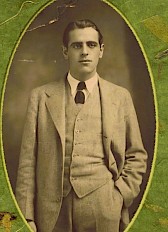 King Haley’s third child was Donald Badger Haley, born in 1907 in Newmarket. He was in the first graduating Class of the new High School on South Main Street- Class of 1925. He entered into UNH, and later Dartmouth. He was employed in 1927 as a sales manager for Central Vermont Public Service Corp, and was living in Springfield, VT in 1933 when he married Hazel Jarvis, a supervisor at the Claremont Telephone Exchange. By 1940 he and Hazel moved to Pittsfield MA, and he was working for a furniture Company in Springfield, MA. He died in Springfield at age 61 in 1969.
King Haley’s third child was Donald Badger Haley, born in 1907 in Newmarket. He was in the first graduating Class of the new High School on South Main Street- Class of 1925. He entered into UNH, and later Dartmouth. He was employed in 1927 as a sales manager for Central Vermont Public Service Corp, and was living in Springfield, VT in 1933 when he married Hazel Jarvis, a supervisor at the Claremont Telephone Exchange. By 1940 he and Hazel moved to Pittsfield MA, and he was working for a furniture Company in Springfield, MA. He died in Springfield at age 61 in 1969.